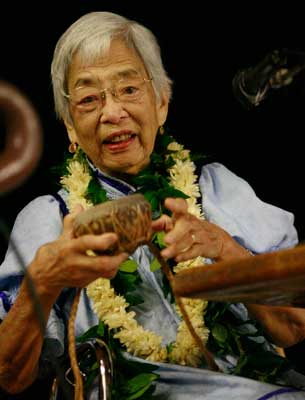Algae expert meshed science and native culture

The world-renowned algae expert, a Hawaiian pioneer in science, died Thursday at age 91.
Isabella Abbott straddled two worlds and excelled in both, mentoring and inspiring generations of scientists and native Hawaiian cultural practitioners.
The world-renowned algae taxonomist and ethnobotanist "loved her people," said Hi’ilei Kawelo, director of Paepae O He’eia, a nonprofit organization dedicated to caring for Heeia Fishpond. "She loved her culture, but she also excelled at it through Western science. She’s someone to look up to (who showed us) that we can do both. We can exist and practice our culture, but also develop this love of science."
The retired University of Hawaii at Manoa ethnobotany professor remained a resource to many in the scientific and native Hawaiian cultural community until her death Thursday, while surrounded by friends and family. She was 91.
A longtime member of the board of directors of the Bishop Museum, Abbott wrote more than 150 research papers and eight books.
"We always saw her as the Energizer Bunny," said Allen Allison, Bishop Museum vice president. "She just lit up every room that she was in."
Born in Hana, Maui, and reared in Honolulu, Abbott got her first limu lessons under her Hawaiian mother’s tutelage, and went on to become the foremost expert on Central Pacific algae.
Don't miss out on what's happening!
Stay in touch with breaking news, as it happens, conveniently in your email inbox. It's FREE!
"She had extraordinary scientific talent, but she also had an incredible knowledge of history," said Allison, a longtime friend.
"She was a wonderful cook," he added, and her knowledge encompassed "songs, meanings of words, the full range of ethnobotany. It’s extraordinary."
Allison, 60, first met Abbott when he was a science student and she was teaching with her husband, Donald, at Stanford University’s Hopkins Marine Station. They became reacquainted and remained friends when the Abbotts moved back to Hawaii in 1978. Donald Abbott preceded his wife in death.
Abbott’s book on limu, published by Bishop Museum, remains "one of the finest examples of the blending of science and culture into something that advances knowledge and builds interest and appreciation amongst a wide array of people," Allison said.
A 1937 graduate of Kamehameha Schools, Abbott received a doctorate in botany from the University of California at Berkeley in 1950. That made her the first Kamehameha graduate and the first native Hawaiian to receive a doctorate in science.
In 1972, she became the first female and first minority full professor in biological sciences at Stanford.
"She was that kupuna we needed for guidance," said Kanekoa Kukea Shultz, a former student and now Kaneohe Bay marine coordinator for the Nature Conservancy. "She would scold us and also love us. You felt good when she scolded you because you knew she cared. She was always there to help support, to make sure there were avenues, not only for Hawaiians, but for women.
"The trail she blazed allowed all of us behind her to walk in her footsteps, to understand we could do anything we want.
"She knew what to plant, what was there, what used to be there," said Shultz, who restores native limu and removes invasive, non-native algae from the bay. "She was that repository of cultural knowledge, which is even more rare — a wealth of knowledge in both worlds, and that’s something we’ll miss."
Abbott’s many accomplishments were detailed last week in a cover story in the UH-Manoa magazine Malamalama. Among them: the Gilbert Morgan Smith Medal from the National Academy of Sciences for excellence in published research on marine or freshwater algae. She was also named a Living Treasure by the Honpa Hongwanji Hawaii.
Abbott is survived by daughter Annie Abbott Foerster and granddaughter Catherine Foerster.






